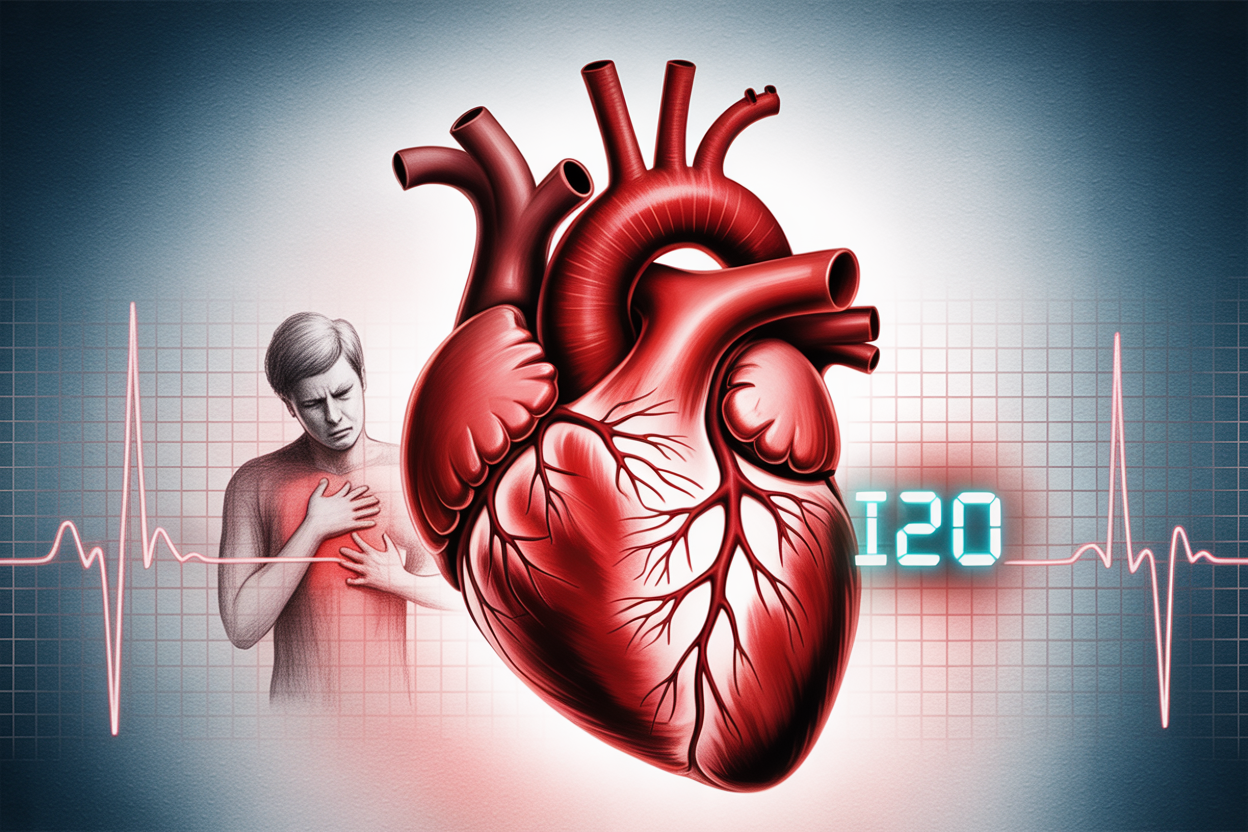Angina pectoris
Angina pectoris, commonly known as just angina, is a medical term that indicates the heart is not receiving enough oxygen-rich blood. It is a type of chest pain. You can think of it as your heart saying, “Hey, I’m running low on fuel!”
This usually happens when the diameter of the coronary arteries becomes narrow or sometimes even gets completely blocked. There can be many reasons for this, such as when you’re exercising, under stress, or facing a lot of pressure. In such situations, the heart needs more oxygen. If it doesn’t get enough oxygen at that moment, you may feel chest pain, tightness, or discomfort — and this condition is called angina.
Table of Contents
Types of Angina with ICD-10 Codes
Stable Angina (I20.8): This is a predictable type of chest pain that usually gets triggered during physical exertion or periods of high stress. It typically goes away with rest or by taking nitroglycerin.
Unstable Angina (I20.0): In this type, the pain is sudden, severe, and lasts longer. It often occurs even while resting. This is a serious condition and should not be ignored, as it increases the risk of a heart attack.
Prinzmetal (Variant) Angina (I20.1): This kind of angina is caused by a sudden and forceful spasm of the coronary artery muscles, leading to restricted blood flow. It can sometimes be very painful.
Other Forms of Angina: This includes microvascular angina, which affects the small coronary arteries. The pain may last longer than in other types. It is more common in women, and often hard to detect on tests like ECG or angiography.
Unspecified Angina (I20.9): This code is used when the specific type of angina is not clearly documented in the medical records.

What is ICD-10
Let’s now talk a bit about the term ICD-10 — it stands for International Classification of Diseases, 10th Revision. Sounds a bit heavy, right?
But in reality, it’s quite simple. It’s a global coding system used by doctors and hospitals to help label and record diseases, symptoms, and other health-related conditions.
Why is it important?
Because these codes:
Are helpful in medical billing
Ensure that all hospitals and healthcare providers use the same healthcare language
Assist in tracking diseases for public health data and medical research.
Specifically ICD-10 code for Angina
Every disease is assigned a specific code under a proper classification system. Similarly, angina pectoris is classified under the ICD-10 code I20. This code is used for all angina-related conditions, regardless of the type — whether it’s stable angina, unstable angina, or caused by artery spasms. If the condition is related to angina, it falls under the I20 code series.
Combination Codes with Other Conditions
Sometimes, a single patient may suffer from multiple heart-related conditions at the same time. For example, in the case of angina — if it’s caused by atherosclerosis (meaning plaque buildup in the arteries), then using a simple angina code isn’t enough. In such cases, a combination code is used, which helps in clearly identifying the exact medical condition.
🔍 Examples:
I25.110 – When angina occurs along with atherosclerotic heart disease.
I25.119 – When unspecified angina is present with atherosclerosis.
I25.118 – When other forms of angina (like stable or atypical angina) are seen with atherosclerosis.
I25.111 – When stable angina occurs with atherosclerosis of native coronary arteries.
Why is this important?
Because most patients often have more than one cardiovascular issue — like coronary artery disease plus angina.
Medical billing becomes more accurate
Treatment plans can be better explained to the patient
Medical records remain clean and reliable
Insurance and claim processes run smoothly
Special Cases: Refractory Angina – When the Pain Just Won’t Go Away
Heart-related conditions can often be quite complex, and Refractory Angina is one of those serious situations.
What Exactly Is Refractory Angina?
Refractory Angina is a type of chronic chest pain that doesn’t get better even after standard treatments — whether it’s medication, stent placement, or even bypass surgery.
In simple words, your heart keeps signaling that it’s not getting enough oxygen, and despite all treatments, the pain still doesn’t go away.
ICD-10 Coding for Refractory Angina
To accurately document this condition, there are special ICD-10 codes assigned just for Refractory Angina:
I20.81 – Refractory Angina without mention of Atherosclerosis
Used when the patient continues to experience persistent chest pain, but no artery blockage or plaque buildup is found in reports.
Example: The patient has undergone multiple treatments, but has been in pain for months, and all tests show no visible blockage.
I25.112 – Refractory Angina due to Atherosclerosis
This code is used when chronic chest pain is caused by atherosclerotic heart disease, which means plaque buildup (such as cholesterol, fat, calcium, or cellular waste) in the coronary arteries.
Example: A patient with a known history of coronary artery disease, who has already had stents placed, but continues to experience chest pain — this would be diagnosed as Refractory Angina with Atherosclerosis.
